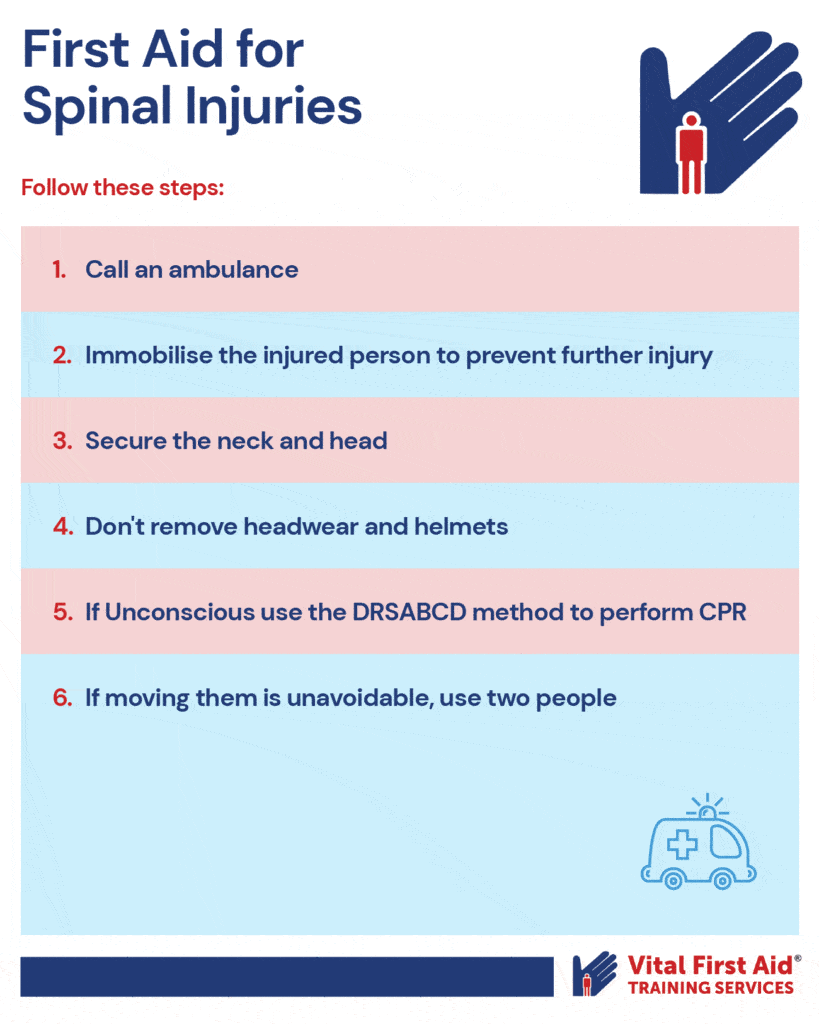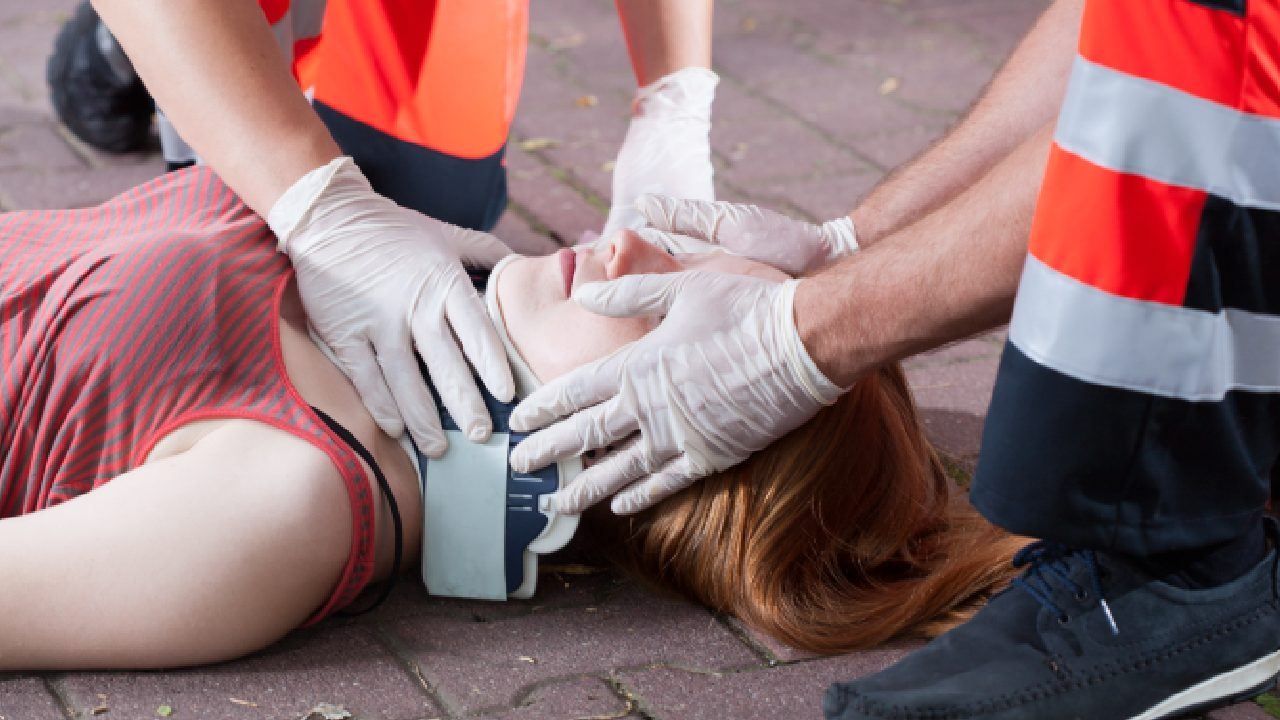The Vital Facts
- Men make up 83% of individuals with spinal cord injuries.
- Each year, there are 350 to 400 new recorded cases of spinal cord injuries.
- The most common age group affected is 15 to 24-year-olds, representing 25% of cases.
Knowing first aid for spinal injuries is essential because you never know the full extent of the injury. They can be life-threatening and cause permanent disability, and in some cases, they can be worsened depending on how first aid is provided.
If one of your loved ones experiences a spinal injury, knowing what to do isn’t just a matter of life and death, it can have an impact on their quality of life even if they do survive.
If someone has suffered a spinal injury, take these first aid steps immediately:
- Call an ambulance
- Immobilise the patient to prevent further injury
- Secure the neck and head
- Don’t remove headwear or helmets
- If unconscious, use the DRSABCD method to perform CPR
- If moving them is unavoidable, use two people
See these first aid steps in more detail here.
To feel confident about how to provide the right first aid for spinal injuries, continue reading this guide.
Jump to:
- What are spinal injuries?
- Are spinal injuries life-threatening?
- What are the symptoms of a spinal injury?
- How to provide first aid for spinal injuries
What are Spinal Injuries?
Spinal injuries, usually caused by a traumatic impact or contortion, are any form of injury that affects the spinal cord. This is the length of vertebrae, nerves and muscles that run from the brainstem to the lower back.
The spinal cord transmits messages from the brain throughout the rest of the body. If it is severed, blocked or otherwise damaged, the areas of the body below where the damage occurs can become partially or completely paralysed.
Are Spinal Injuries Life-Threatening?
A spinal injury can be life-threatening if it occurs very close to the brain stem, or if it causes paralysis that affects core bodily processes, like breathing and swallowing. Generally though, people fear the often permanent impact of spinal injuries, like paraplegia or quadriplegia.
Paralysis can cause people to lose their independence, and makes general activities like walking difficult or impossible. The thought of being permanently immobilised is what makes spinal injuries so terrifying.
What are the Symptoms of a Spinal Injury?
Like with head injuries and concussions, it is essential that you take any sign of a spinal injury seriously in an accident that involves the head, neck or back. If you see any of the following symptoms, call an ambulance immediately.
- A sense of weakness or paralysis
- Loss of sensation to touch, temperature and pain
- Numbness or tingling, especially in the extremities
- Spasms or uncontrollable motor functions
- Difficulty with balance and walking, including a lack of depth perception
- A strong stinging sensation caused by damaged nerve fibres
- Severe pain or pressure in the head, neck or back
- An obviously twisted neck or back
- Difficulty breathing and inability to clear throat and lungs
- Loss of bladder or bowel control
Important note: You don’t have to experience all of these symptoms to have a spinal injury. A combination of them could be present, or they could develop at different rates over time.
How to Provide First Aid for Spinal Injuries
If you’ve noticed one or more of the symptoms of a spinal injury, you need to commence first aid immediately. Spinal injuries can become worse when ignored due to further movement.

1. Call an Ambulance
Call an ambulance immediately. It’s better to call it and not need it than the other way round. If you’re concerned about whether the injured person wants the ambulance, call it anyway. The paramedics can discuss it with the patient when they arrive.
2. Immobilise the Injured Person
Movement after an injury is one of the greatest risk factors for further injury. If they are moving around, have them hold still, preferably on their back with their head straight. You can’t fix the injury, so the goal is simply to prevent it from getting worse. If they are in pain, being immobilised should also hurt less than if they move.
3. Secure the Neck and Head
As well as immobilising their body, you want to take special care to keep their neck and head still. This is especially true if they are having involuntary spasms or seizures, or if they are shivering from going into shock.
To do this, a good idea is to use something soft but heavy, like a large towel or a blanket, to pad around their head to naturally support it and prevent them from looking side-to-side.
People who suffer serious spinal injuries will often panic and look around, especially if there is a lot of activity like at a roadside accident. It is particularly important in these situations that you calm them down and make sure that they refrain from moving.
4. Don’t Remove Headwear or Helmets
A first instinct if someone is wearing headwear or a helmet is to take it off to assess the injury. This is a mistake.
Removing it will often include tilting the head forward or backward to undo clips and straps. This risks worsening the injury. Unless the helmet is obstructing their breathing, leave it on.
5. If Unconscious Use DRSABCD
If the spinal injury patient is unconscious and isn’t breathing or doesn’t have a pulse, you’ll need to perform CPR. Follow the DRSABCD method:
D- Danger
R – Response
S – Send for help
A – Airway
B – Breathing
C – Start CPR if no breathing
D – Defibrillation
In DRSABCD, usually you would tilt the injured person’s head backwards to inspect their airway. Don’t do this when providing first aid for spinal injuries. While keeping them alive with CPR is the priority, still do what you can to limit unnecessary head movement.
6. Use Two People if they Need to be Moved
If the injured person is choking, vomiting or in a dangerous position such as a busy highway, moving them might be unavoidable.
In this case, try to have a second person assist you. While one person either rolls their body onto its side or lifts them up, the other can hold their head and neck and make sure it stays aligned with their body. If a third person is available, get them to help hold the legs, especially if it is a lower back injury.
Feel Confident with Vital First Aid Training
Receiving the right first aid for spinal injuries is one of the most important factors in an injured person’s chances of recovery. To truly feel confident, it’s a good idea to take a proper, certified first aid course. At Vital First Aid, we offer one that is tailored to emergency care for spinal injuries.
But why stop there?
We also have courses for a wide range of other first aid types. True first aid prowess comes from being taught professionally, and at Vital First Aid pride ourselves on the effectiveness of our courses.
To book one, get in touch today.
Courses are available throughout Sydney, Newcastle and the Central Coast.



